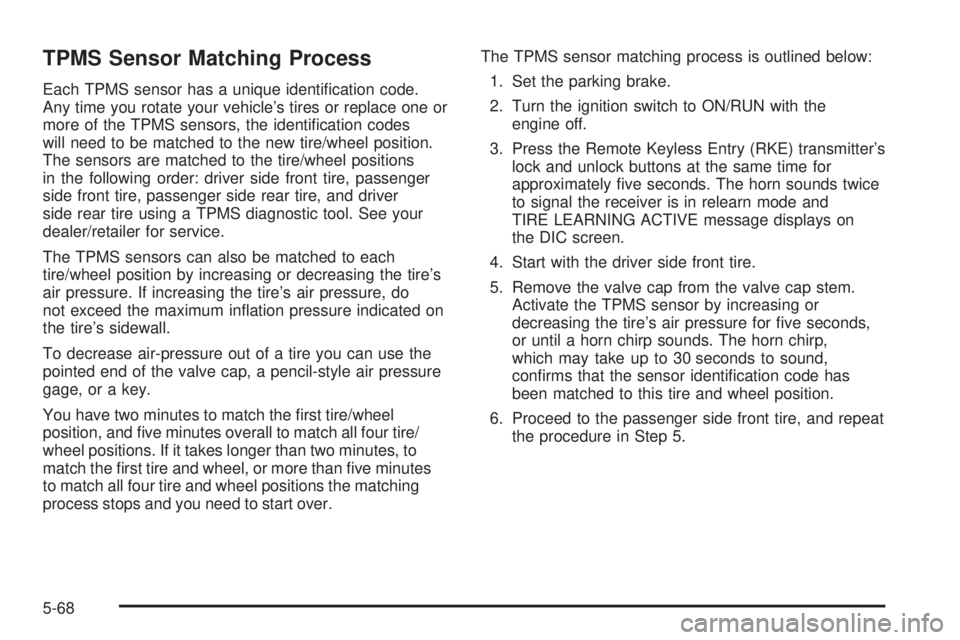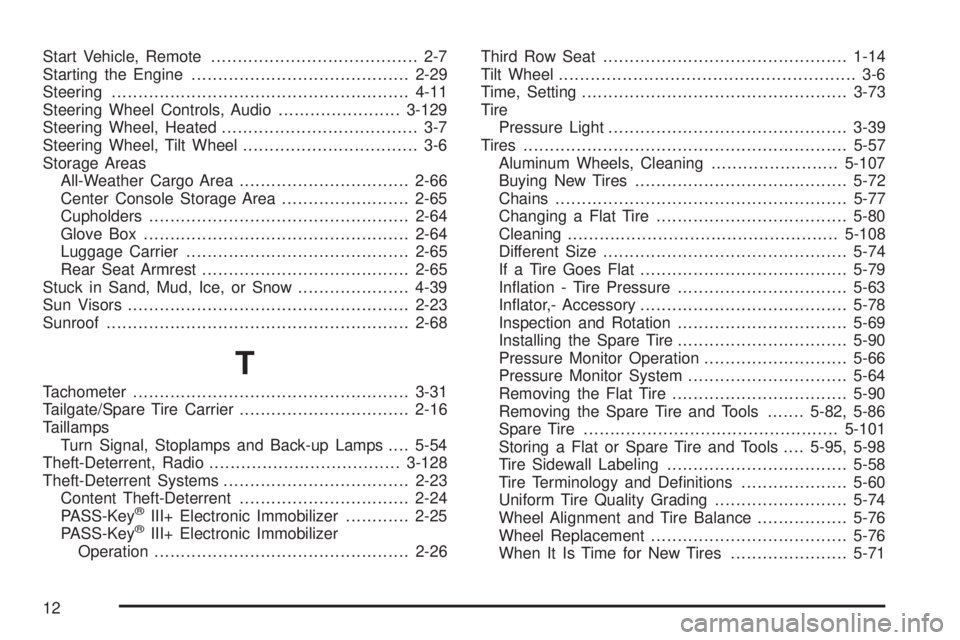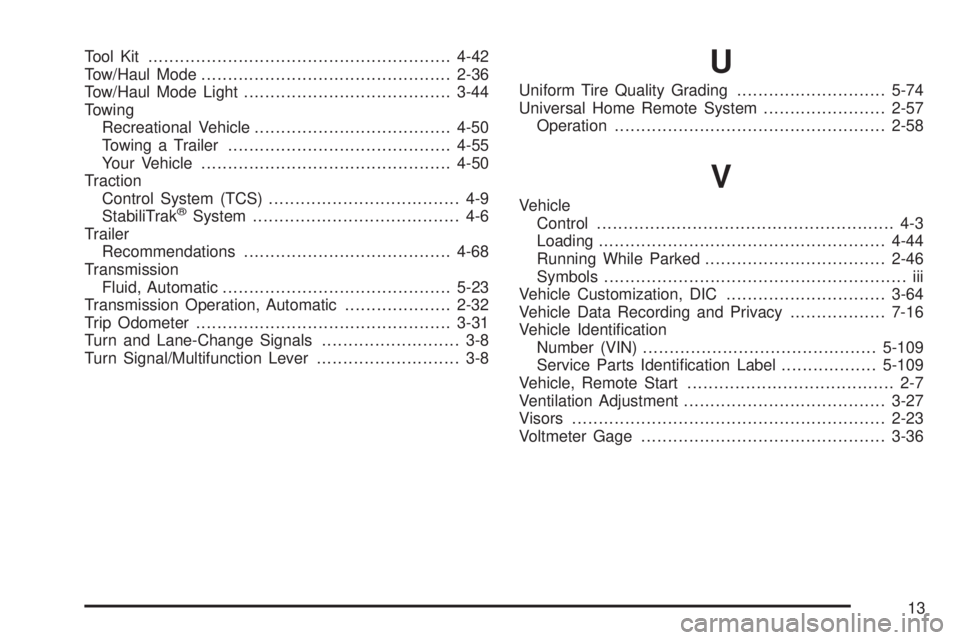remote start HUMMER H2 2009 Owner's Manual
[x] Cancel search | Manufacturer: HUMMER, Model Year: 2009, Model line: H2, Model: HUMMER H2 2009Pages: 524, PDF Size: 3.1 MB
Page 369 of 524

A. Coolant Surge Tank. SeeCooling System on
page 5-27.
B. Engine Air Cleaner/Filter and Air Filter Restriction
Indicator (If Equipped). SeeEngine Air Cleaner/Filter
on page 5-20.
C. Windshield Washer Fluid Reservoir. See “Adding
Washer Fluid” underWindshield Washer Fluid
on page 5-37.
D. Engine Oil Fill Cap. See “When to Add Engine Oil”
underEngine Oil on page 5-15.
E. Engine Oil Dipstick. See “Checking Engine Oil”
underEngine Oil on page 5-15.
F. Air Filter Restriction Indicator (If Equipped).
SeeEngine Air Cleaner/Filter on page 5-20.
G. Automatic Transmission Fluid Dipstick. See
“Checking the Fluid Level” underAutomatic
Transmission Fluid on page 5-23.
H. Engine Cooling Fan. SeeCooling System on
page 5-27.
I. Remote Negative (−) Terminal (GND). SeeJump
Starting on page 5-42.
J. Power Steering Fluid Reservoir (Out of View).
SeePower Steering Fluid on page 5-36.K. Remote Positive (+) Terminal. SeeJump Starting on
page 5-42.
L. Brake Fluid Reservoir. See “Brake Fluid” under
Brakes on page 5-38.
M.Underhood Fuse Block on page 5-113.
N.Battery on page 5-41.
Engine Oil
Checking Engine Oil
It is a good idea to check the engine oil level at each
fuel �ll. In order to get an accurate reading, the oil must
be warm and the vehicle must be on level ground.
The engine oil dipstick handle is a yellow loop. See
Engine Compartment Overview on page 5-14for
the location of the engine oil dipstick.
1. Turn off the engine and give the oil several minutes
to drain back into the oil pan. If this is not done, the
oil dipstick might not show the actual level.
2. Pull out the dipstick and clean it with a paper towel
or cloth, then push it back in all the way. Remove it
again, keeping the tip down, and check the level.
5-15
Page 397 of 524

Notice:If the other vehicle’s system is not a 12-volt
system with a negative ground, both vehicles can
be damaged. Only use vehicles with 12-volt systems
with negative grounds to jump start your vehicle.
2. Get the vehicles close enough so the jumper cables
can reach, but be sure the vehicles are not touching
each other. If they are, it could cause a ground
connection you do not want. You would not be able
to start your vehicle, and the bad grounding
could damage the electrical systems.
To avoid the possibility of the vehicles rolling, set
the parking brake �rmly on both vehicles involved
in the jump start procedure. Put an automatic
transmission in P (Park) or a manual transmission
in N (Neutral) before setting the parking brake.
Notice:If you leave the radio or other accessories
on during the jump starting procedure, they could be
damaged. The repairs would not be covered by the
warranty. Always turn off the radio and other
accessories when jump starting the vehicle.
3. Turn off the ignition on both vehicles. Unplug
unnecessary accessories plugged into the cigarette
lighter or accessory power outlets. Turn off the
radio and all lamps that are not needed. This will
avoid sparks and help save both batteries. And
it could save your radio!4. Open the hoods and locate the positive (+) and
negative (−) terminal locations of the other vehicle.
Your vehicle has a remote positive (+) jump
starting terminal and a remote negative (−) jump
starting terminal. You should always use these
remote terminals instead of the terminals on the
battery.
The remote positive (+)
terminal is located near the
engine accessory drive
bracket. On some vehicles,
the terminal may be
covered by a red plastic
cover. To access the
remote positive (+)
terminal, open the cover,
if equipped.
5-43
Page 400 of 524

10. Now start the vehicle with the good battery and run
the engine for awhile.
11. Try to start the vehicle that had the dead battery.
If it will not start after a few tries, it probably needs
service.
Notice:If the jumper cables are connected or
removed in the wrong order, electrical shorting may
occur and damage the vehicle. The repairs would
not be covered by the vehicle warranty. Always
connect and remove the jumper cables in the correct
order, making sure that the cables do not touch
each other or other metal.
A. Heavy, Unpainted Metal Engine Part or Remote
Negative (−) Terminal
B. Good Battery or Remote Positive (+) and
Negative (−) Terminals
C. Dead Battery or Remote Positive (+) TerminalJumper Cable Removal
5-46
Page 422 of 524

TPMS Sensor Matching Process
Each TPMS sensor has a unique identi�cation code.
Any time you rotate your vehicle’s tires or replace one or
more of the TPMS sensors, the identi�cation codes
will need to be matched to the new tire/wheel position.
The sensors are matched to the tire/wheel positions
in the following order: driver side front tire, passenger
side front tire, passenger side rear tire, and driver
side rear tire using a TPMS diagnostic tool. See your
dealer/retailer for service.
The TPMS sensors can also be matched to each
tire/wheel position by increasing or decreasing the tire’s
air pressure. If increasing the tire’s air pressure, do
not exceed the maximum in�ation pressure indicated on
the tire’s sidewall.
To decrease air-pressure out of a tire you can use the
pointed end of the valve cap, a pencil-style air pressure
gage, or a key.
You have two minutes to match the �rst tire/wheel
position, and �ve minutes overall to match all four tire/
wheel positions. If it takes longer than two minutes, to
match the �rst tire and wheel, or more than �ve minutes
to match all four tire and wheel positions the matching
process stops and you need to start over.The TPMS sensor matching process is outlined below:
1. Set the parking brake.
2. Turn the ignition switch to ON/RUN with the
engine off.
3. Press the Remote Keyless Entry (RKE) transmitter’s
lock and unlock buttons at the same time for
approximately �ve seconds. The horn sounds twice
to signal the receiver is in relearn mode and
TIRE LEARNING ACTIVE message displays on
the DIC screen.
4. Start with the driver side front tire.
5. Remove the valve cap from the valve cap stem.
Activate the TPMS sensor by increasing or
decreasing the tire’s air pressure for �ve seconds,
or until a horn chirp sounds. The horn chirp,
which may take up to 30 seconds to sound,
con�rms that the sensor identi�cation code has
been matched to this tire and wheel position.
6. Proceed to the passenger side front tire, and repeat
the procedure in Step 5.
5-68
Page 500 of 524

Coverage
Services are provided up to 5 years/100,000 miles
(160 000 km), whichever comes �rst.
In the U.S., anyone driving the vehicle is covered.
In Canada, a person driving the vehicle without
permission from the owner is not covered.
Roadside Assistance is not a part of the New Vehicle
Limited Warranty. HUMMER and General Motors
of Canada Limited reserve the right to make any
changes or discontinue the Roadside Assistance
program at any time without noti�cation.
HUMMER and General Motors of Canada Limited
reserve the right to limit services or payment to an owner
or driver if they decide the claims are made too often,
or the same type of claim is made many times.
Services Provided
Emergency Fuel Delivery:Delivery of enough fuel
for the vehicle to get to the nearest service station.
Lock-Out Service:Service is provided to unlock the
vehicle if you are locked out. A remote unlock may
be available if you have OnStar
®. For security
reasons, the driver must present identi�cation
before this service is given.
Emergency Tow From a Public Road or Highway:
Tow to the nearest HUMMER dealer for warranty
service, or if the vehicle was in a crash and cannot
be driven.
Flat Tire Change:Service is provided to change a
�at tire with spare tire. The spare tire, if equipped,
must be in good condition and properly in�ated. It is
your responsibility for the repair or replacement of
the tire if it is not covered by the warranty.
Battery Jump Start:Service is provided to jump
start a dead battery.
Trip Routing Service:Detailed maps of North
America are provided when requested either with the
most direct route or the most scenic route. Additional
travel information is also available. Allow three
weeks for delivery.
Trip Interruption Bene�ts and Assistance:
If your trip is interrupted due to a warranty failure,
incidental expenses may be reimbursed during the
5 year/100,000 miles (160 000 km) Powertrain
warranty period. Items considered are hotel, meals,
and rental car.
7-8
Page 510 of 524

OnStar®
If your vehicle has OnStar and you subscribe to the
OnStar services, please refer to the OnStar Terms and
Conditions for information on data collection and
use. See alsoOnStar
®System on page 2-54in this
manual for more information.
Navigation System
If your vehicle has a navigation system, use of the
system may result in the storage of destinations,
addresses, telephone numbers, and other trip
information. Refer to the navigation system operating
manual for information on stored data and for deletion
instructions.
Radio Frequency
Identi�cation (RFID)
RFID technology is used in some vehicles for functions
such as tire pressure monitoring and ignition system
security, as well as in connection with conveniences
such as key fobs for remote door locking/unlocking and
starting, and in-vehicle transmitters for garage door
openers. RFID technology in GM vehicles does not use
or record personal information or link with any other
GM system containing personal information.
7-18
Page 520 of 524

Power Winch Platform.....................................4-43
Privacy..........................................................7-16
Event Data Recorders..................................7-17
Navigation System.......................................7-18
OnStar .......................................................7-18
Radio Frequency Identi�cation.......................7-18
Programmable Automatic Door Locks.................2-11
R
Radio Frequency Identi�cation (RFID), Privacy....7-18
Radio(s)........................................................3-75
Radios
Navigation/Radio System, see Navigation
Manual.................................................3-107
Rear Seat Audio........................................3-127
Reception.................................................3-129
Setting the Clock.........................................3-73
Theft-Deterrent..........................................3-128
Reading Lamps..............................................3-18
Rear Air Conditioning and Heating System and
Electronic Climate Controls...........................3-28
Rear Axle......................................................5-47
Locking......................................................4-10
Rear Door Security Locks................................2-12
Rear Heated Seats.........................................1-10
Rear Seat Armrest..........................................2-65
Rear Seat Audio (RSA)..................................3-127
Rear Seat Entertainment System.....................3-118Rear Vision Camera........................................2-50
Rear Windshield Washer/Wiper.........................3-11
Rearview Mirror, Automatic Dimming..................2-47
Reclining Seatbacks, Power............................... 1-8
Recommended Fluids and Lubricants.................6-13
Recovery Loops..............................................4-40
Recreational Vehicle Towing.............................4-50
Remote Keyless Entry (RKE) System.................. 2-4
Remote Keyless Entry (RKE) System, Operation . . . 2-5
Remote Vehicle Start........................................ 2-7
Removing the Flat Tire and Installing the
Spare Tire..................................................5-90
Removing the Spare Tire and Tools...........5-82, 5-86
Replacement Bulbs.........................................5-55
Replacement Parts, Maintenance......................6-15
Reporting Safety Defects
Canadian Government..................................7-15
General Motors...........................................7-15
United States Government............................7-14
Restraint System Check
Checking the Restraint Systems....................
1-80
Replacing Restraint System Parts
After a Crash..........................................1-81
Retained Accessory Power...............................2-29
Ride Height, Selectable Extended Rear Ride......4-52
Roadside
Service........................................................ 7-7
Rocking Your Vehicle to Get it Out....................4-40
Routing, Engine Drive Belt...............................6-16
Running the Vehicle While Parked.....................2-46
10
Page 522 of 524

Start Vehicle, Remote....................................... 2-7
Starting the Engine.........................................2-29
Steering........................................................4-11
Steering Wheel Controls, Audio.......................3-129
Steering Wheel, Heated..................................... 3-7
Steering Wheel, Tilt Wheel................................. 3-6
Storage Areas
All-Weather Cargo Area................................2-66
Center Console Storage Area........................2-65
Cupholders.................................................2-64
Glove Box..................................................2-64
Luggage Carrier..........................................2-65
Rear Seat Armrest.......................................2-65
Stuck in Sand, Mud, Ice, or Snow.....................4-39
Sun Visors.....................................................2-23
Sunroof.........................................................2-68
T
Tachometer....................................................3-31
Tailgate/Spare Tire Carrier................................2-16
Taillamps
Turn Signal, Stoplamps and Back-up Lamps....5-54
Theft-Deterrent, Radio....................................3-128
Theft-Deterrent Systems...................................2-23
Content Theft-Deterrent................................2-24
PASS-Key
®III+ Electronic Immobilizer............2-25
PASS-Key®III+ Electronic Immobilizer
Operation................................................2-26Third Row Seat..............................................1-14
Tilt Wheel........................................................ 3-6
Time, Setting..................................................3-73
Tire
Pressure Light.............................................3-39
Tires.............................................................5-57
Aluminum Wheels, Cleaning........................5-107
Buying New Tires........................................5-72
Chains.......................................................5-77
Changing a Flat Tire....................................5-80
Cleaning...................................................5-108
Different Size..............................................5-74
If a Tire Goes Flat.......................................5-79
In�ation - Tire Pressure................................5-63
In�ator,- Accessory.......................................5-78
Inspection and Rotation................................5-69
Installing the Spare Tire................................5-90
Pressure Monitor Operation...........................5-66
Pressure Monitor System..............................5-64
Removing the Flat Tire.................................5-90
Removing the Spare Tire and Tools.......5-82, 5-86
Spare Tire................................................5-101
Storing a Flat or Spare Tire and Tools....5-95, 5-98
Tire Sidewall Labeling..................................5-58
Tire Terminology and De�nitions....................5-60
Uniform Tire Quality Grading.........................5-74
Wheel Alignment and Tire Balance.................5-76
Wheel Replacement.....................................5-76
When It Is Time for New Tires......................5-71
12
Page 523 of 524

Tool Kit .........................................................4-42
Tow/Haul Mode ...............................................2-36
Tow/Haul Mode Light.......................................3-44
Towing
Recreational Vehicle.....................................4-50
Towing a Trailer..........................................4-55
Your Vehicle...............................................4-50
Traction
Control System (TCS).................................... 4-9
StabiliTrak
®System....................................... 4-6
Trailer
Recommendations.......................................4-68
Transmission
Fluid, Automatic...........................................5-23
Transmission Operation, Automatic....................2-32
Trip Odometer................................................3-31
Turn and Lane-Change Signals.......................... 3-8
Turn Signal/Multifunction Lever........................... 3-8
U
Uniform Tire Quality Grading............................5-74
Universal Home Remote System.......................2-57
Operation...................................................2-58
V
Vehicle
Control........................................................ 4-3
Loading......................................................4-44
Running While Parked..................................2-46
Symbols......................................................... iii
Vehicle Customization, DIC..............................3-64
Vehicle Data Recording and Privacy..................7-16
Vehicle Identi�cation
Number (VIN)............................................5-109
Service Parts Identi�cation Label..................5-109
Vehicle, Remote Start....................................... 2-7
Ventilation Adjustment......................................3-27
Visors...........................................................2-23
Voltmeter Gage..............................................3-36
13